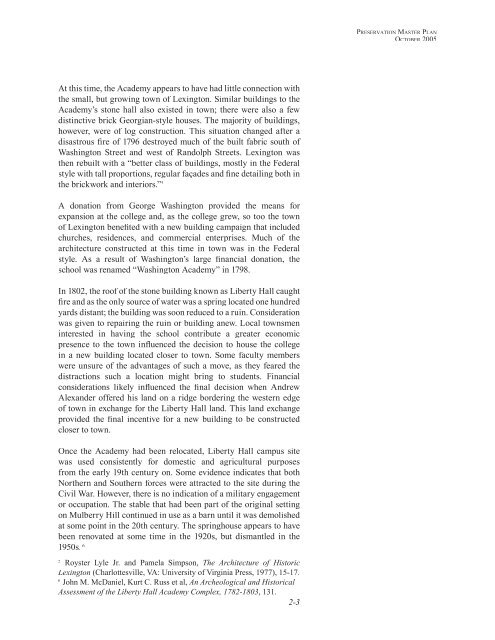A BRIEF HISTORY OF WASHINGTON AND LEE - Society for ...
A BRIEF HISTORY OF WASHINGTON AND LEE - Society for ...
A BRIEF HISTORY OF WASHINGTON AND LEE - Society for ...
You also want an ePaper? Increase the reach of your titles
YUMPU automatically turns print PDFs into web optimized ePapers that Google loves.
PRESERVATION MASTER PLANOCTOBER 2005At this time, the Academy appears to have had little connection withthe small, but growing town of Lexington. Similar buildings to theAcademy’s stone hall also existed in town; there were also a fewdistinctive brick Georgian-style houses. The majority of buildings,however, were of log construction. This situation changed after adisastrous fire of 1796 destroyed much of the built fabric south ofWashington Street and west of Randolph Streets. Lexington wasthen rebuilt with a “better class of buildings, mostly in the Federalstyle with tall proportions, regular façades and fine detailing both inthe brickwork and interiors.” 5A donation from George Washington provided the means <strong>for</strong>expansion at the college and, as the college grew, so too the townof Lexington benefited with a new building campaign that includedchurches, residences, and commercial enterprises. Much of thearchitecture constructed at this time in town was in the Federalstyle. As a result of Washington’s large financial donation, theschool was renamed “Washington Academy” in 1798.In 1802, the roof of the stone building known as Liberty Hall caughtfire and as the only source of water was a spring located one hundredyards distant; the building was soon reduced to a ruin. Considerationwas given to repairing the ruin or building anew. Local townsmeninterested in having the school contribute a greater economicpresence to the town influenced the decision to house the collegein a new building located closer to town. Some faculty memberswere unsure of the advantages of such a move, as they feared thedistractions such a location might bring to students. Financialconsiderations likely influenced the final decision when AndrewAlexander offered his land on a ridge bordering the western edgeof town in exchange <strong>for</strong> the Liberty Hall land. This land exchangeprovided the final incentive <strong>for</strong> a new building to be constructedcloser to town.Once the Academy had been relocated, Liberty Hall campus sitewas used consistently <strong>for</strong> domestic and agricultural purposesfrom the early 19th century on. Some evidence indicates that bothNorthern and Southern <strong>for</strong>ces were attracted to the site during theCivil War. However, there is no indication of a military engagementor occupation. The stable that had been part of the original settingon Mulberry Hill continued in use as a barn until it was demolishedat some point in the 20th century. The springhouse appears to havebeen renovated at some time in the 1920s, but dismantled in the1950s. 65Royster Lyle Jr. and Pamela Simpson, The Architecture of HistoricLexington (Charlottesville, VA: University of Virginia Press, 1977), 15-17.6John M. McDaniel, Kurt C. Russ et al, An Archeological and HistoricalAssessment of the Liberty Hall Academy Complex, 1782-1803, 131.2-3
















